About – What's new
Specify basins and protrusions by drawing their outer boundary
SCALGO Live has long supported creating basins and protrusions having side slopes with a given gradient. The way this works is that you draw a polygon covering the bottom of your basin or the top of your protrusion (hill). Then you specify a gradient, and SCALGO Live automatically interpolates between the drawn flat area and the surrounding terrain while respecting the specified gradient.
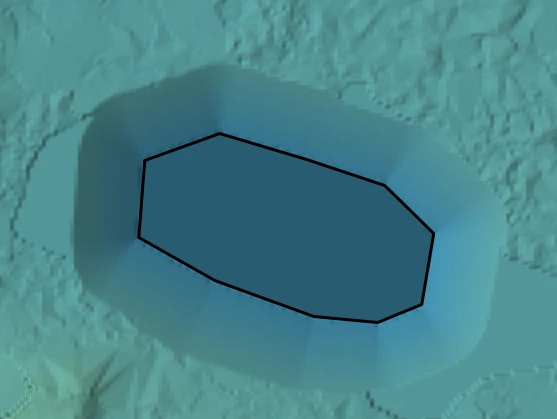
A basin created by drawing the bottom area and adding slopes on the outside.
There are use cases, however, where it is more natural to be able to specify the outer boundary of your basin or hill. For example, you may have a given plot of land where you want to create water storage.
SCALGO Live now supports this use case: Again you draw a polygon and specify a gradient, but this time SCALGO Live adds the slope on the inside.
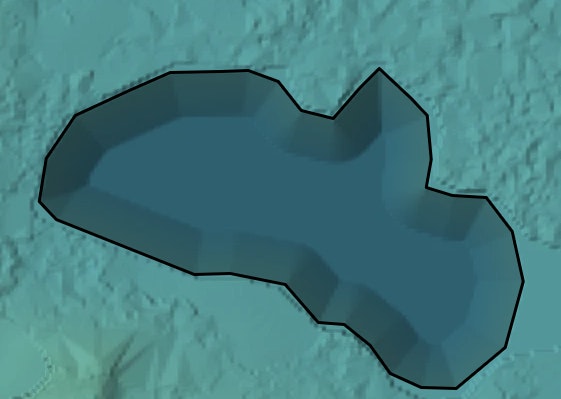
A basin created by drawing the outer boundary and adding slopes on the inside.
The tools you have always used for creating basins and protrusions now support both ways of specifying side slopes. Use the checkbox "Side slopes are outside" if you want to add slopes on the outside of your area (the default is now to add them on the inside).
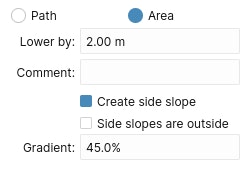
The new controls for specifying if side slopes go on the inside or on the outside of the drawn area.
The two modes behave a bit differently:
- When adding outside slopes, the polygon you draw is a flat horizontal polygon (since it's the bottom of your basin), so in the profile view you will see all vertices at the same elevation (and you cannot change this). How far the side slopes will go depends on the elevation of the terrain, for an uneven terrain it is not easily predictable.
- When adding inside slopes, the polygon you draw actually has 3D coordinates (SCALGO Live automatically samples the terrain at each vertex). This makes it possible to create a basin whose outside aligns with the terrain along the given area boundary. From these 3D coordinates, SCALGO Live then computes the appropriate sloping to achieve the target depth (or height for protrusions). The depth is always measured from the lowest boundary vertex, the height is measured from the highest boundary vertex.
When you edit the boundary of such a basin, you may have to readjust the elevations at the vertices to make sure it again aligns with the terrain, otherwise you'll have sharp edges on the boundary.
Simplified path features
Since the very beginnings of SCALGO Live, it was possible to modify the terrain model to see how this influences the flow of water and the various analyses.
The first tools were quite simple, and allowed you to draw walls, depressions, or protrusions with vertical walls only. Then came side slopes for more realistic dams and basins, the possibility to specify the cross section (for instance to represent a river bed according to actual measurements), and most recently the ability to create a terrain by drawing contour lines.
Until now, when you draw a path feature using the "interpolate", "raise", or "raise flat" tools without any side slopes, it was still represented in the terrain as we implemented it in the first version many years ago (top figure below).
We have now changed it so that when you create a simple path without side slopes or general cross sections, it is added to the terrain using the same method that we use for general paths (that is, for paths with side slopes or cross sections). As you can see in the bottom figure, this avoids the traditional plateaus at each vertex, and in general fits better with the other ways of using our tools.
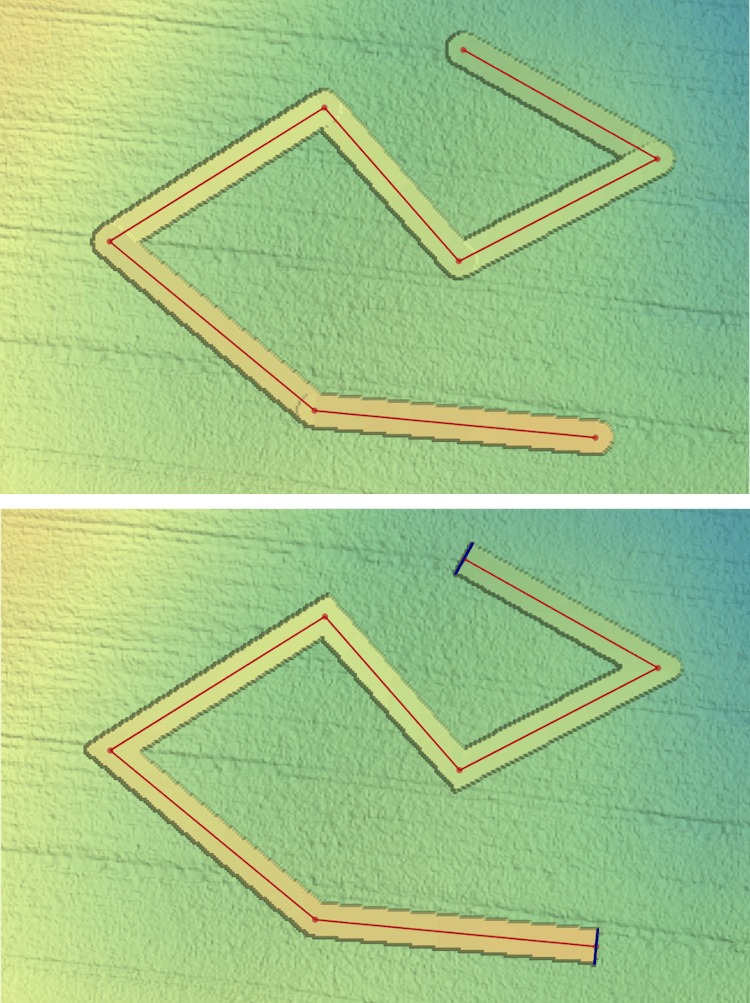
(top) Old path style with rounded edges and discontinuities at joints. (bottom) New default path style.
It is worth noting that the new method is applied only to newly created features - your existing features remain unchanged. If you want an existing path feature to use the new method, use "Edit both cross sections" from the context menu, select "Width only", and save again. Note that you will not be able to go back to the traditional way, though.
National Norwegian high-resolution land cover map
Today we announce the availability of a nationwide high-resolution land cover map for SCALGO Live in Norway. The map, produced by SCALGO, is based on machine learning techniques and has a resolution of 25 cm.
It is available as a standalone layer in the Land cover category in the library.
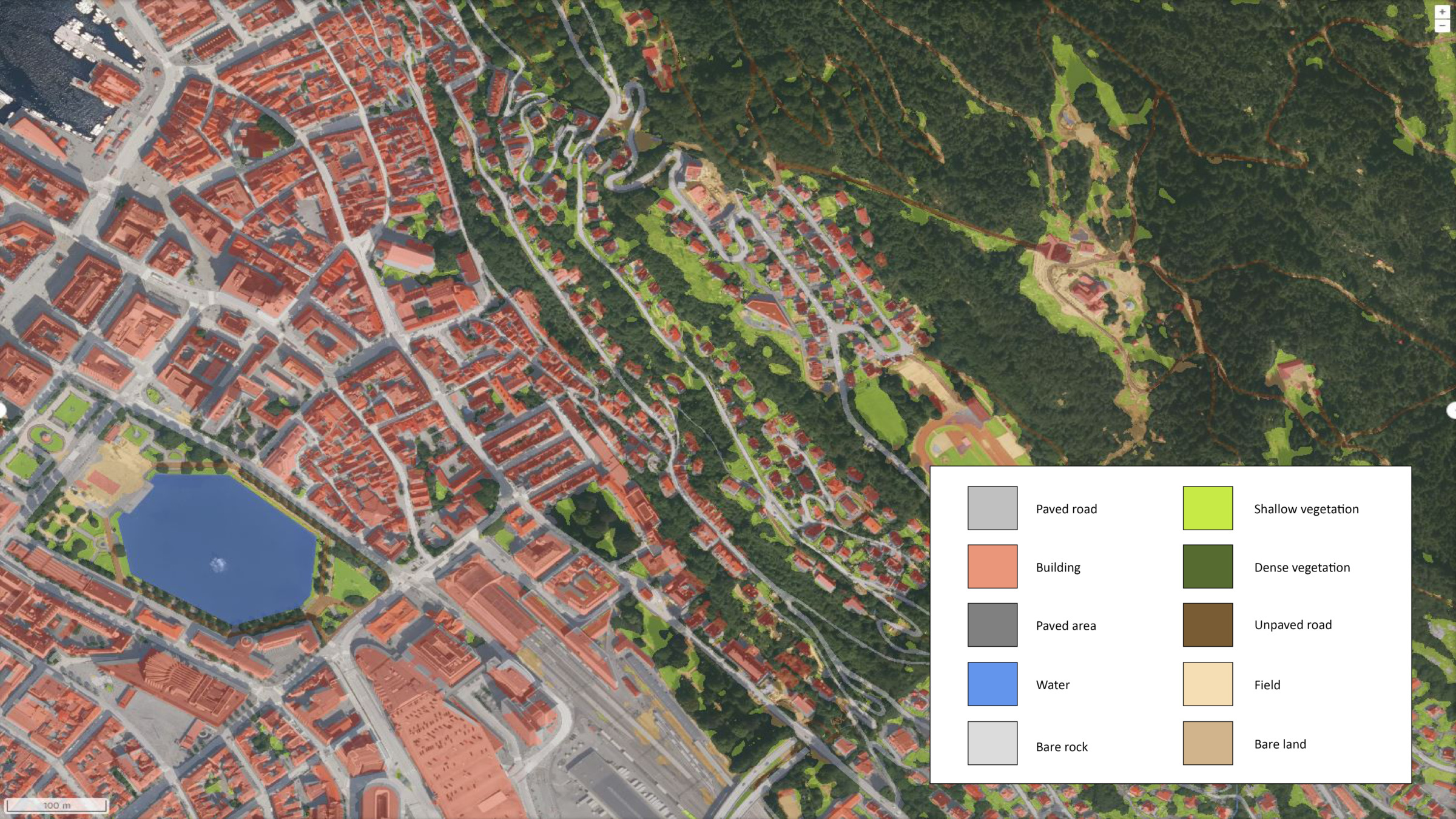
The map is fully integrated into SCALGO Live Norway and is, for instance, used to show aggregate land cover information for watershed queries. For more information please see the complete release announcement.
Organise and communicate on a digital canvas
Say hello to Canvas, a brand-new extension of SCALGO Live released today.
Use Canvas to organise and communicate your work by drawing shapes and placing comments directly on top of existing maps, analyses, and workspaces. Easily combine data from various sources by uploading your own vectors or extract results from SCALGO Live directly to your Canvas.
Canvas is the easiest way to start creating your plans and projects. Work together with your team, clients or stakeholders to conceptualize ideas and solutions. Store meeting notes directly on top of maps and analyses, and share entire project documentations in Canvas with the team.
Check out the Canvas page for more inspiration on how to use the new tools in your work. We can't wait to see all the cool things that you will do with Canvas.
Watch the Getting started-video for an introduction to Canvas
Join webinar on the 8th of November at 10:00 (CET)
Join the webinar for an introduction to Canvas and a guide on how to use the new tools. See a few illustrative use-cases for inspiration on how to start using Canvas in your work.
New sidebar to help organize your analyses and queries
From now on, all sliders, info boxes and computation tasks will appear in the new sidebar. The sidebar can be collapsed to enlarge the map, or expanded to get an overview of sliders and query results.
Test it out:
- Turn on one of the analyses in the left menu
- Use one on the query tools in the top bar
Check out the video below for a quick introduction to the new sidebar.
You can read more about the sidebar in the documentation.
Sliding contours
Not so long ago we released beautiful and detailed nationwide contour maps with intervals of 50 cm and 2.5 m. Now we introduce a whole new contour map that allows you to select the contour interval that suits your purpose and scale. This powerful tool will make it easier to adjust the view to your desired level of detail.
For more information, please see the accompanying blog post.
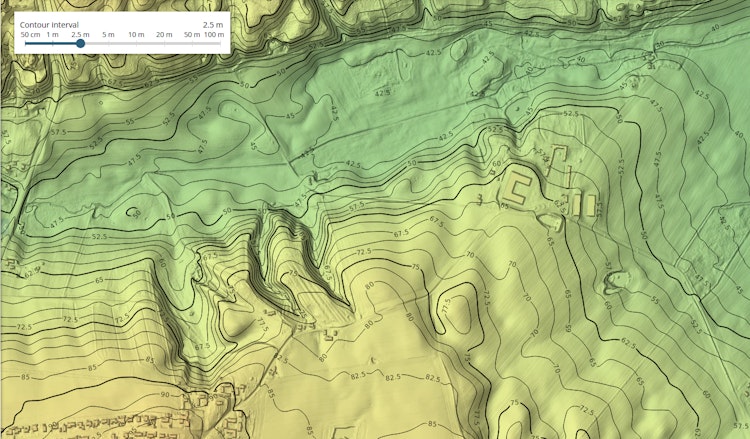
The contour slider set to show contours at a 2.5m interval.
Ny skyfallsanalys och en ännu bättre marktäckekarta
Spännande nytt i SCALGO Live! 🤩 Vi har utvecklat en helt ny skyfallskarta som tar hänsyn til infiltration för olika jordarter samt avdrag för ledningsnät. Dessutom har vi lanserat en ny högupplöst marktäckekarta med ännu fler klasser.
Se en kort introduktion
Webinar om den nya releasen
Den 20 juni, kl 14 genomgick Hampus Åkerblom, marknadschef i Sverige, hur den nya skyfallsanalysen och marktäckekartan är utvecklad och hur du kan arbeta med dessa i SCALGO Live.
Läs mera om denna lansering i bloggen
Blogginlägg om marktäckekartan: Ny marktäckekarta med ännu flera klasser
Blogginlägg om skyfallsanalysen: Skyfallskarta med infiltration och avdrag för ledningsnät
New land cover map for Finland
We are happy to announce that SCALGO Live in Finland has been updated with a new land cover map covering the entire country. The land cover map is produced using a machine learning model developed by SCALGO, in close collaboration with SYKE (The Finnish Environment Institute).
The new map is based on a powerful machine learning model that allows us to classify each pixel into the following categories: impervious, shallow vegetation, dense vegetation and bare land. These four land cover classes are supplemented with auxiliary data from DigiRoad and Maastotietokanta, to create a map with 10 unique classes.
The map is fully integrated into SCALGO Live and is, for instance, used to show aggregate land cover information for watershed queries. For more information please read the accompanying blog post.
Depths in the depression map
Now you can work with depths in the depression map.
Recently, we added a new feature to the Depression map based on requests from users. This latest update is, for example, useful when designing ponds and wetlands with focus on biodiversity.
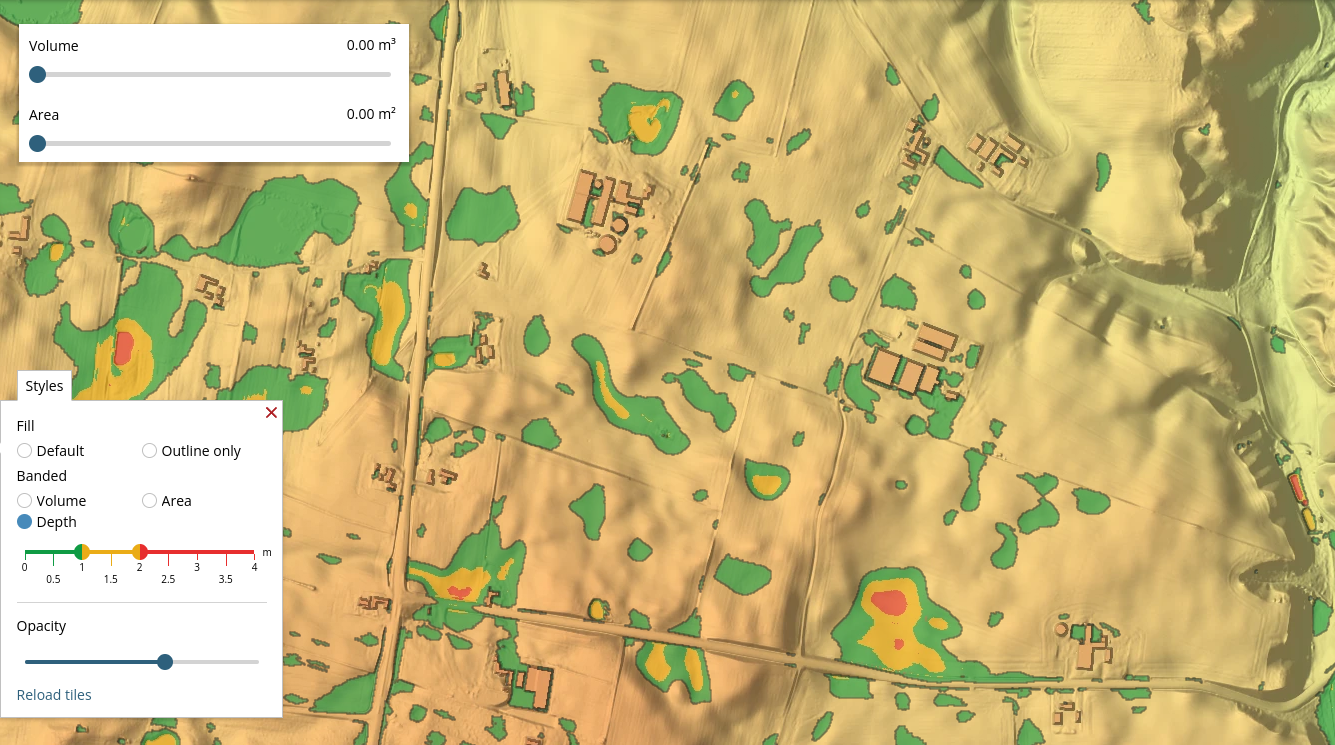
Read the blog to see how to get more out of the depression map in your projects.
New Danish land cover map with more classes
We have released a major upgrade to our nationwide Danish land cover map. The previous map was based on a machine learning model that could distinguish between pervious and impervious areas, on top of this we added data from GeoDanmark to enrich the map with forest, building and surface water (lakes) classes.
The new map is based on a much more powerful machine learning model that allows us to classify each pixel into the following categories: impervious, shallow vegetation, dense vegetation and bare land. On top of this we have added an expanded set of GeoDanmark classes to mark buildings, agricultural fields, surface water (now also from streams) as well as paved and unpaved roads. The result is a high-resolution national land cover map with 9 classes, as summarised in the below graphic.
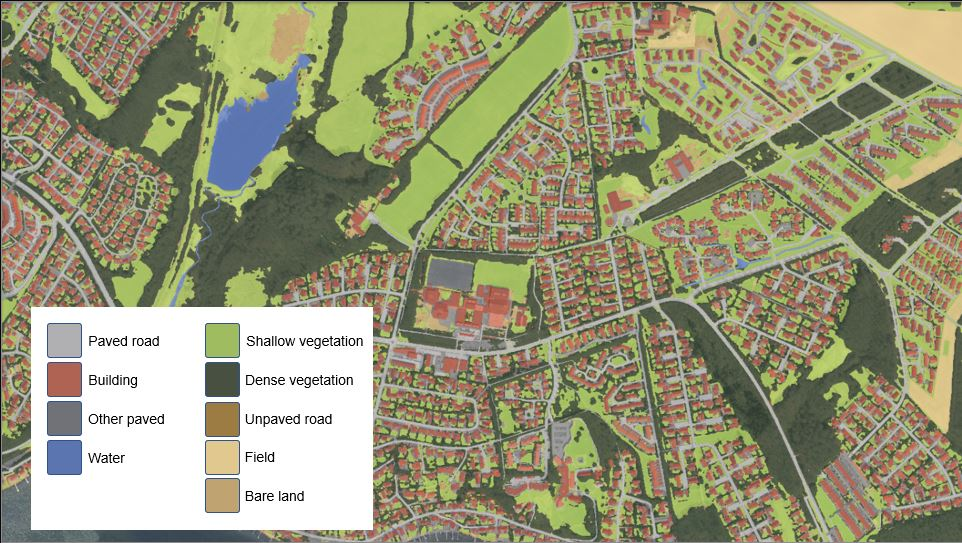
We have also upgraded the Flash Flood Map to use the new classes, and in particular we are excited about the dense vegetation class that replaces the forest polygons, providing a much better mapping of those high-infiltration areas.
For more information please read the accompanying blog post (in Danish).